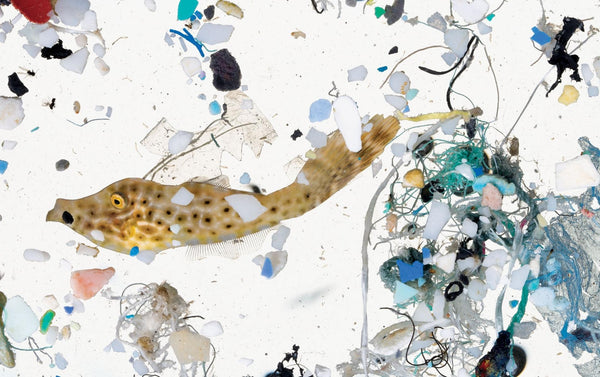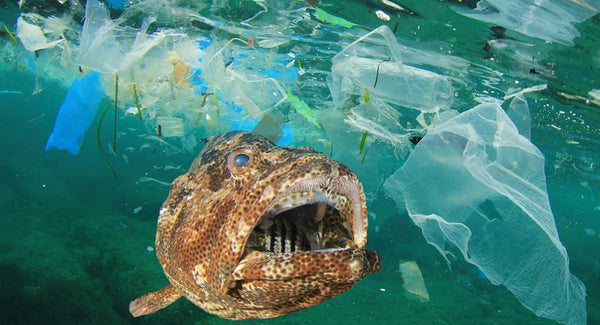Per la versione italiana di questo post, clicca qui
“We could be swallowing a credit card’s weight in plastic every week,” according to a new study referenced in a recent CNN article, according to the study by the University of Newcastle, in Australia commissioned by the World Wildlife Fund (“WWF”). That’s enough to make us think twice about our plastic use! The largest source of plastic ingestion is drinking water, including both bottled and tap water, according to researchers. Shellfish is the second biggest source. How is this possible!? These tiny particles, called microplastics, make their way into our rivers and oceans, are eaten by fish and other marine animals, and end up in the food chain.

We already know that plastic is a problem. However, there is an additional consequence of plastic which has begun to come to light in recent years which is less visible. Microplastics are small plastic pieces less than five millimeters long, but just because they are tiny does not mean we can or should ignore them! They have disastrous consequences for marine life and could remain in the ocean forever. So we might be eating them for a while!
Microplastics come from a variety of different sources. This includes debris from large plastic items that have been broken down over time into smaller fragments, as well as resin pellets that are used for plastic manufacturing. Waves, sunlight, or other physical stress, breaks the plastic into smaller pieces. For example, the waste in the “Garbage Patches” degrade into smaller pieces, and there is a lot of trash there! You may have heard time periods quoted for how long it takes plastic to degrade in the environment, whereas it actually just breaks down in to smaller and smaller pieces.

Another form of microplastic is microbeads (made up of manufactured polyethylene plastic), which until recently were commonly added to health and beauty products — like cleansers and toothpastes — as exfoliants. However, in January 2019, a request was submitted to the European Commission to restrict the addition of microplastics to products, with opinions expected by Spring 2020. Unfortunately, this type of microplastic only makes up about 2% of microplastics released.
A lesser known source of microplastics come from the human use of an object that gives off microplastics, such as tires and clothing with synthetic fibers. Unfortunately, with the solution is more complex with these as it is difficult to substitute such products.
Clothing can release a significant amount of synthetic fibers when machine washed. Fleece gives off the most, though athletic wear and other synthetic fabrics do also. They release thousands of fibers every time that you wash them. One fleece jacket in the wash can release up to 2 grams of microfibers per wash, some 250,000 fibers. 40% of them make it past wastewater treatment and out into water systems!
What is the Impact?
The problem with microplastics is that they are so small that they are usually not picked up by water filtration and make it out into rivers and oceans. Fish and other aquatic animals eat them and they die or have health problems. Not only fish are affected, so are worms, zooplankton, and crustaceans. Fish then eat these prey species and the plastic accumulates inside of them. They can feel full because their stomachs are full of plastic and not get enough of the food that they actually need, causing them to die of starvation. And let’s not forget that we humans eat fish and sea salt, therefore, ultimately, the plastic ends up in us!
The microplastics never dissolve and stay in the ocean forever. Plastic does not biodegrade because it is new to the environment and bacteria have not evolved to break down the carbon-carbon links found in plastic. Plastic can constantly be broken down into smaller pieces but will always remain there.

There is growing concern about the health risks microplastics pose to human health, but the full impacts of plastic pollution remain unclear. There is evidence that microplastics can absorb toxins and contaminants and carry these harmful substances from the water column and into the organisms that consume them, such as fish.
So what can we do? Plenty! Awareness alone is a powerful starting point. Simply making informed decisions regarding our purchases and consumption will already begin to break the cycle.
Firstly, choosing beauty and cleaning products with natural ingredients or making such products yourself not only avoids microplastics, but also prevents exposure to harmful toxic ingredients.
Additionally, consider switching to sponges and brushes with natural materials to avoid releasing microplastics into the water while doing dishes (traditional commercial sponges are made of synthetic materials!).
Secondly, buying used clothing or clothing with natural materials (cotton, silk, linen) as opposed to synthetic materials (i.e. polyester) reduces the release of microplastics while doing laundry. You can also consider washing clothing less, as we are accustomed to washing clothing more than truly necessary.
Alternatively, the use of the Guppyfriend washing bag allows you to wash clothing with synthetic materials in the laundry, capturing the microfibers and avoiding their release into the water system.
Lastly, the less plastic we consume overall, the less opportunity there is to our products to break down and become microplastics. Changing habits and moving towards a low-plastic or plastic-free lifestyle is the push we need to stop this plastic pollution. For now we’re consuming a credit card’s worth of plastic – let’s hope it doesn’t become a full wallet of plastic!




